Boat Anchoring
An Essential Skill For A Cruising Sailor
Imagine not being able to park your car (please, no dry humour here!) or stop it when you want to pause – say in a parking lot. That's what anchoring is for a boat. You may want to enjoy a quiet spot for lunch or a swim on a hot afternoon or tuck into an isolated cove for the night. You may need to stop the motion of your boat if your engine has quit or if you are in danger of being blown ashore. All of these require some proficiency with anchoring.
It starts with selecting the best anchor. There is no one single 'best' type of anchor. Anchors are selected for the type of bottom you will have under you as well as for their holding power. The most common anchors on the Great Lakes are the Danforth, the CQR/Plow and the Bruce.
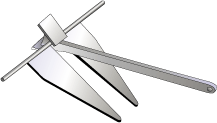 |
The Danforth anchor uses two large flat hinged flukes designed to dig
into the bottom and set. It can have difficulty on very weedy or on
rocky bottoms. They are lighter than other anchors, Sometimes the broad
flukes can cause it to 'fly' as it is dropped. |
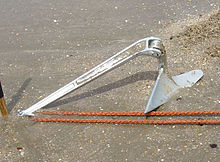 |
The CQR/Plow has fixed flukes and a hinged shank. It is generally good on all bottoms but not designed for any one type in particular. |
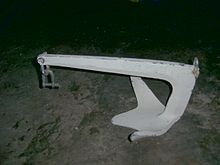 |
The Bruce is a single piece claw-shaped anchor. It sets fairly quickly and has very good holding power. Again, weedy bottoms pose a challenge sometimes. |
Many sailors carry two anchors, each a different design.
An anchor is just part of the system. Now I am sure you all know that there is only one rope on a boat (Can you name it? It's at the bottom of the page.) – only lines and specially-named lines such as a halyard or sheet. The line that attaches the anchor to the boat is called the 'rode'.
The RODE
Anchor rodes can be comprised of all chain, all line or, most usually, a combination of both. There may be other items that are part of the anchor system such as a kellet or sentinel, shackles, etc. Collectively, this is called ground tackle. The last point in the system is the attachment point on the boat itself. It does no good if the anchor and its line are attached to a weakened or damaged cleat. Check it and if there is any flex or looseness, get it repaired.
The free end of a line is called the 'bitter end' from a time when it was the part of a line that was fastened to 'bitts' or posts. Which by the way is the origin of the English expression 'reaching the bitter end' – a line that had run out to its bitter end had nothing further left. The bitter end of an anchor rode should be secured to your boat. This prevents the embarrassing situation of releasing the anchor only to watch the entire line disappear overboard. Believe me, it has happened more often than you may care to imagine!
In an emergency, where you absolutely must get free of your anchor, you can cut the line and leave. (This by the way is the origin of the term 'cut and run', ie cut the rode and run before the wind to avoid a storm or being caught anchored by a larger, hostile ship.) Remember that the strength of your anchor system is only as strong as the weakest element.
A strong anchor attached to strong chain in turn attached to a stout rode and then secured to a damaged cleat is only as strong as that cleat.
ANCHORAGE
Once you decide to anchor, 'where' becomes a major consideration. A 'fair weather' anchorage offers some protection from wind and waves and may be good for a break to enjoy a swim or lunch. It may be in the lee of an island or simply off a nice beach. However, if the wind were to shift, you might find yourself threatened by a lee shore as the wind tries to drive you onto a beach.
An 'all weather' anchorage offers a much more protected location such as a bay. If you are anchoring overnight, you will want to refer to not just your chart but also to a weather forecast. Your chart will give you information on depth (for scope) and bottom type (for holding). The weather report will let you know if wind shifts are likely overnight or the possibility of squalls. If there are other boats sharing the anchorage, take a few minutes to study them – their location, how close they are together and how much room you will have to swing on your anchor.
BOTTOM
Both the Canadian and US Chart 1 (see RESOURCE Section for copies) list 17 different types of seabed. These range from sand and mud to boulders, weeds and gravel. The type of bottom is shown on the charts. Knowing the type of bottom will dictate the best type of anchor to use or even whether or not to try and anchor at all.
SCOPE
Determine the scope or amount of rode that you want deployed. This is a ratio of the sum of the depth of the water + distance to the waterline to the length of rode payed out. The standard ratio is between 6 and 8 to 1. For example, if you were anchoring in 10' of water and your deck was 2' above water, and you wanted to use a ratio of 7:1, the length of rode would be calculated as 7 x (10+2) = 84 feet of rode. The smaller the ratio, the less able the anchor is to hold. After a ratio of 10:1, improvements in holding are minimal.
To make things easier, its helpful to mark off intervals on your anchor rode with a ribbon, piece of cord or tie inserted and tied through the strands eg 1 tie at 10 yards or 10 m, 2 at 20 and so on. Using ties or colours are easier to see in low light than numbers that will inevitable wash off.
And what should that rode consist of? Three-strand, medium lay nylon, 3/8 to 5/8 inches, is likely the best as it is both strong and can stretch as much as 20%. The exact size will depend on the size of your boat. To that is added 10-15 ft / 3-4 m of 3/ 8 to 7/16 inch chain to connect the rode to the anchor. This will cause the anchor to lay out on the bottom. It will decrease the angle of pull on the anchor and will also serve to absorb shock loads on the anchor from excessive rising and falling of the bow.
This effect can be increased if needed by sliding a weight (called a 'kellet') down along the anchor rode which increases the curve in the rode giving it even more shock-absorbing ability.
Be aware that your boat could swing in a 360° circle so carefully check the swing room in all directions. Try and find out what scope any neighbouring boats have out to ensure that you can't come in contact with each other.
ANCHORING
When you have identified where you want your anchor, cruise slowly up to that point. Facing into the wind, stop and lower (don't throw!) your anchor until it is laying on the bottom. Slowly back off, paying out rode. Backing off slowly will help ensure that the chain does not foul the anchor. When all the rode has been payed out, gently back down on the anchor to set it in the bottom. Keep a hand lightly on the rode. If the anchor sets, the anchor rode will be steady. If it doesn't, you will feel the bumps as the anchor bounces on the bottom. That being the case, repeat the process.
Once the anchor has been set, take several bearings to at least two reference points on shore such as a building, a prominent feature such as a tall tree, spire, etc. Note these bearings because you will check them several times in the next couple of hours to ensure that your anchor is not dragging. Once you are satisfied that the anchor is set, establish an anchor watch where those bearings are regularly checked to ensure the anchor does not begin to drag at some point later on.
Some sailors use an anchor buoy or float attached to the anchor. While it may seem like a good idea in helping to retrieve the anchor, it offers far more opportunities to foul either the anchor itself or your prop than it is ever worth using. If it were to foul your prop and cause you to drift, the first instinct is to start the engine. The end result would be a freed anchor, fouled prop and stalled boat adrift – not a good combination at all.
When its time to haul anchor, retrieve it by pulling in on the rode and ensuring that all rode is safely on deck. Do this until you are directly over where the anchor is resting. As the bow passes the vertical point, cleat the rode off and let the weight of the boat break the anchor free. Raise the anchor to the waterline and clean any debris from it before securing to the bow roller or anchor hangers. Clean off any debris from the rode and, if time permits, allow it to dry before stowing.
|
By the way, the only rope on a boat is the rope that is attached to the clapper on a ship's bell. |
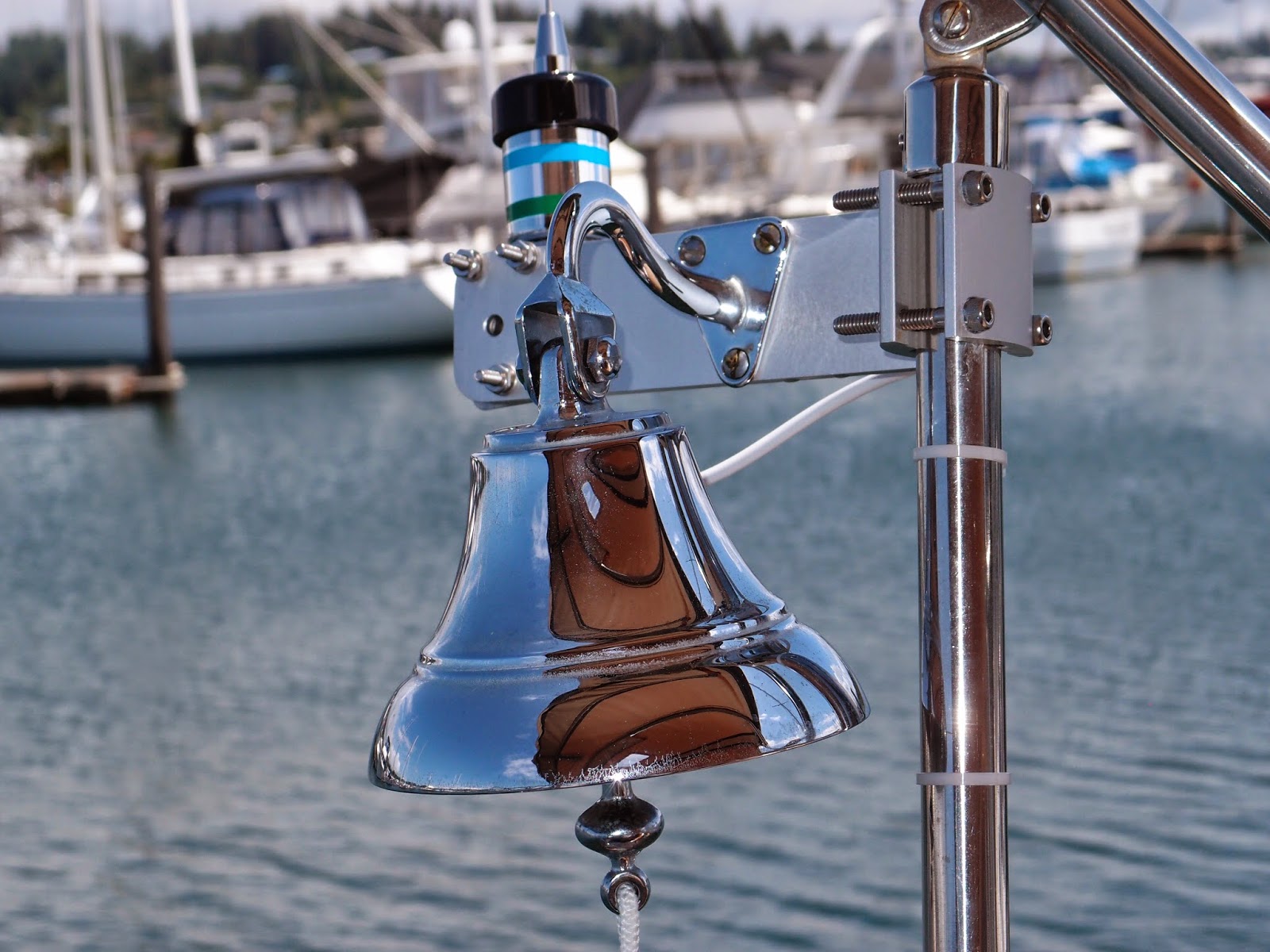 |
Click here to return to SEAMANSHIP
Click here to return HOME
The Complete Log Book For Cruising Sailors
written by a sailor for sailors
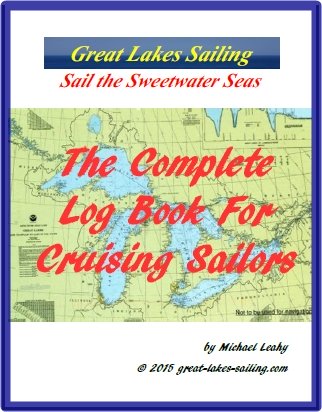
a practical, easy-to-use yet thorough format to record all of the necessary information about your boat and any cruises you take – whether exploring home waters or voyaging to distant ports across the Great Lakes.
.
Click here for more details